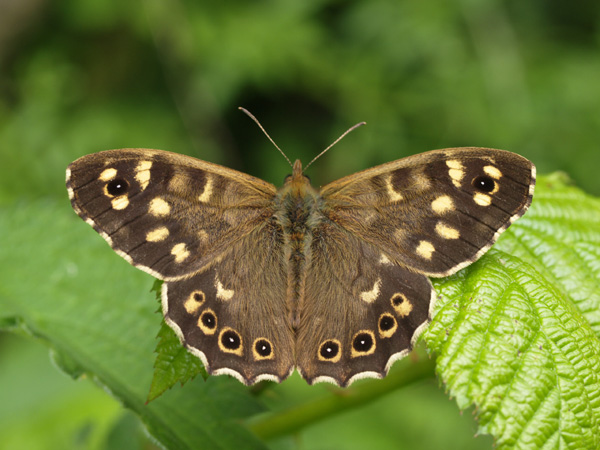
| Butterfly Conservation |
 |
| Hertfordshire & Middlesex Branch |
 |
|
|||
| Saving butterflies, moths and our environment | ||||


Speckled WoodParage aegeriaWidespread and common Distribution and Status In the 1980s the Speckled Wood was mostly seen in western Hertfordshire and western Middlesex with a few colonies scattered elsewhere. The expansion had already started from the south and west, and the butterfly is now widely distributed in the two counties. Since the start of this century, though, numbers have dropped quite significantly, probably as a result of increased woodland management including widening of rides, less favoured by this insect Habitat Requirements A woodland butterfly as the name suggests but it can often be seen along hedgerows in the wider countryside as well as gardens Larval Foodplants Cock's-foot Dactylis glomerata, Common Couch Elymus repens in meadows and False Brome Brachypodium sylvaticum in open woodland Adult Food Sources Common Michaelmas Daisy Aster x salignus, Buddleia Buddleja davidii, Bramble Rubus fruticosus agg., Iceplant Sedum spectabile), Common Ragwort Senecio jacobaea Behaviour/Observation notes The Speckled Wood has been the subject of many studies regarding its behaviour. Males establish territories mostly in sunny but sheltered spots in woodland and along hedgerows about one or two metres above ground Life History The Speckled Wood produces two generations a year although they overlap because of the extended emergence of the first brood. Those that hibernate as pupae emerge in April whereas those that overwintered as larvae usually emerge some weeks later. Because of the overlap there are several peaks: usually in the first week of May, middle of June, late July and late August/early September. Nevertheless, in suitable areas, it may be seen in every week between late March and early October. Specimens seen in October could be from a small third brood. Eggs are usually laid singly on the underside of a leaf of grass. Larvae feed on the leaves. As winter approaches, some larvae enter hibernation whilst others form pupae attached to a grass stem or leaf. This is the only known British species which passes the winter in two different stages Further information
UK distribution map |
Copyright Butterfly Conservation © 2019 Hertfordshire & Middlesex Branch
Privacy and Copyright Statement and Cookie Policy Statement
Butterfly Conservation
Company limited by guarantee, registered in England (2206468)
Registered Office: Manor Yard, East Lulworth, Wareham, Dorset, BH20 5QP. Tel: 01929 400 209
Charity registered in England & Wales (254937) and in Scotland (SCO39268). VAT No. GB 991 2771 89